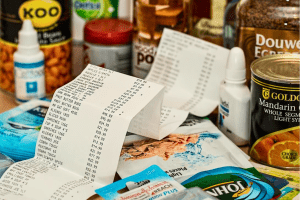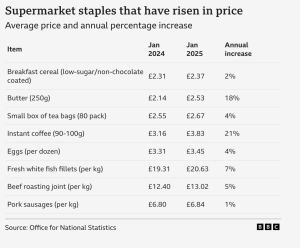Food security – the consistent access to sufficient, safe and nutritious food – is a critical concern in the UK. Our team looked at some recent research and data to provide insights into the current state of food security and the factors influencing food prices that we are all noticing.
UK Food Security Overview
The UK Food Security Index 2024 offers an assessment of the nation’s food security status, examining aspects such as global food availability, domestic supply sources, supply chain resilience, household food security and consumer confidence (Source). It describes how the UK’s food supply chain has faced major challenges in recent years, including the COVID-19 pandemic, rising production costs, import disruptions from global conflicts, Brexit, labour shortages and concerns over fairness in the industry. On top of this, unpredictable weather due to climate change is making food production even more difficult (Source).
Bread Strike in April 2025: No Hot Cross Buns this Easter?
In a recent interview with GB News, farmer Olly Harrison issued a stark warning about the challenges facing UK agriculture, particularly the potential impact on bread wheat production. He highlighted how rising costs, unpredictable weather and the recent changes to inheritance tax could make it harder for farmers to keep their businesses running. With wheat being a staple ingredient in many of our everyday foods, any disruption to production could have serious consequences for supply chains and food prices.
“We want to remind them [the public and MPs] that the food chain is fragile, us farmers are needed, UK production is needed. We don’t want to be importing wheat that’s grown to lesser standards than us, used with chemicals that we banned here 20years ago.”
This interview reinforces the key issues; food security in the UK is under increasing strain due to economic pressures, labour shortages and global disruptions. As our food system becomes more fragile, it’s vital to understand the challenges farmers face and how they impact the cost and availability of food. Watch the full interview:
Food Prices
Food prices have experienced notable fluctuations in recent years. In March 2023, the UK saw a peak food inflation rate of 19.1%. By December 2024, this rate had moderated to 2%, reflecting a significant decrease over the year (Source). The Food Foundation’s Food Prices Tracker indicates that food prices are projected to increase by an average of 4.2% in the latter half of 2025. This anticipated rise is partly attributed to policy changes, such as increases in the national minimum wage and employer national insurance contributions (Source).
Factors Influencing Food Prices
Several elements contribute to the fluctuations in food prices:
- Production Costs: Increases in wages and operational expenses can lead to higher costs for producers, which may be passed on to consumers.
- Supply Chain Resilience: Disruptions in the supply chain, whether due to environmental events or logistical challenges, can affect the availability and cost of food products.
- Global Demand: Rising global populations and changing consumption patterns can increase demand for certain foodstuffs, influencing prices (Source).

Impact on Households
The Office for National Statistics reports that between January 2022 and January 2024, the overall price of food and non-alcoholic beverages rose by approximately 25%. This significant increase has implications for household budgets, particularly affecting low-income families (Source).

Addressing Food Security
To mitigate these challenges, ongoing research and policy initiatives aim to bolster the UK’s food system resilience. Efforts include optimising supply chains, supporting sustainable agricultural practices and implementing measures to ensure the affordability and accessibility of nutritious food for everyone. Understanding these dynamics is crucial for consumers and policymakers alike, as they navigate the complexities of food security and work towards a stable and equitable food system in the UK.

